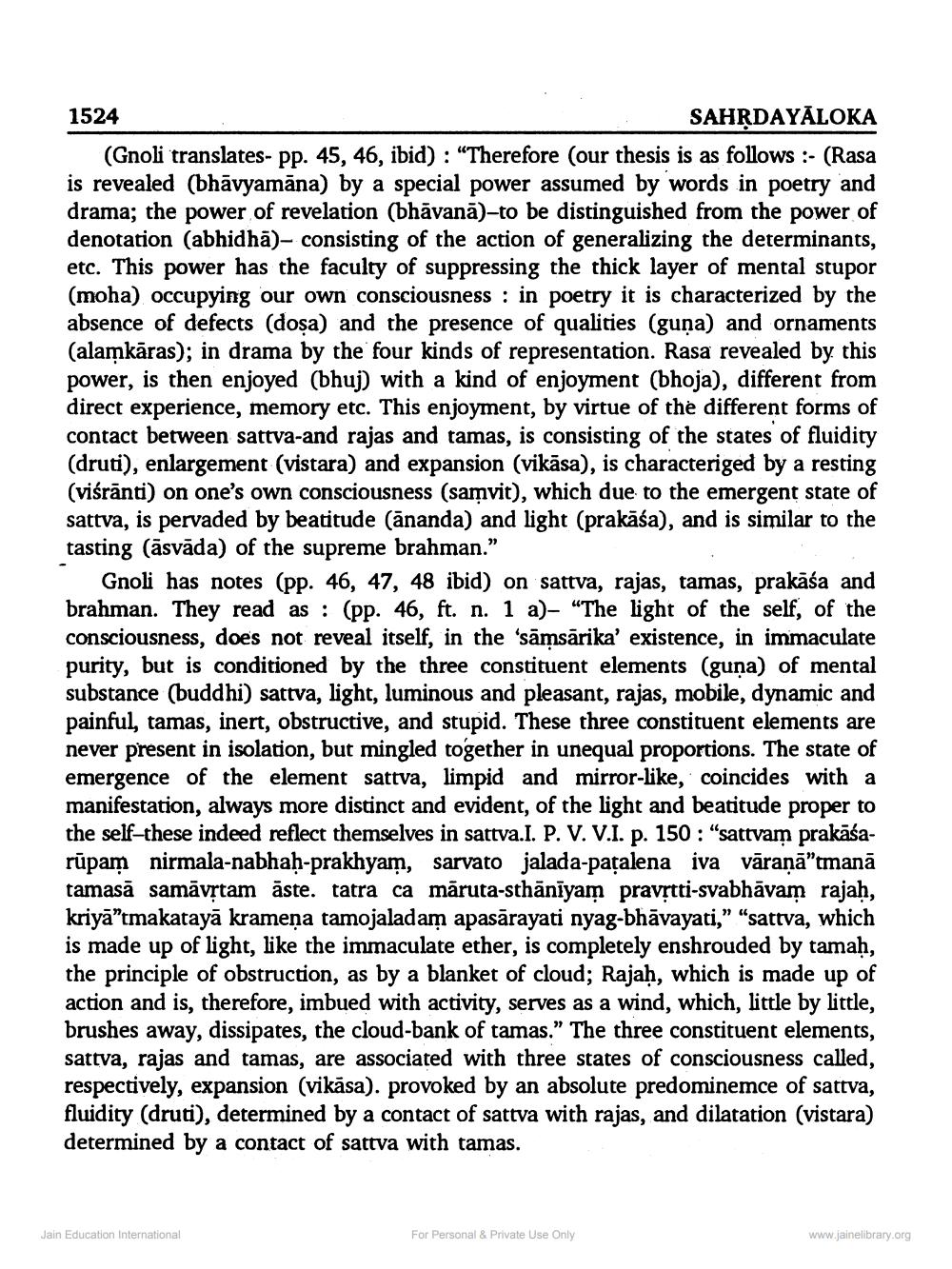________________
1524
SAHRDAYĀLOKA (Gnoli translates- pp. 45, 46, ibid): "Therefore (our thesis is as follows :- (Rasa is revealed (bhāvyamāna) by a special power assumed by words in poetry and drama; the power of revelation (bhāvanā)-to be distinguished from the power of denotation (abhidhā)- consisting of the action of generalizing the determinants, etc. This power has the faculty of suppressing the thick layer of mental stupor (moha) occupying our own consciousness : in poetry it is characterized by the absence of defects (dosa) and the presence of qualities (guna) and ornaments (alamkāras); in drama by the four kinds of representation. Rasa revealed by this power, is then enjoyed (bhuj) with a kind of enjoyment (bhoja), different from direct experience, memory etc. This enjoyment, by virtue of the different forms of contact between sattva-and rajas and tamas, is consisting of the states of fluidity (druti), enlargement (vistara) and expansion (vikāsa), is characteriged by a resting (viśrānti) on one's own consciousness (samvit), which due to the emergent state of sattva, is pervaded by beatitude (ananda) and light (prakāśa), and is similar to the tasting (āsvāda) of the supreme brahman."
Gnoli has notes (pp. 46, 47, 48 ibid) on sattva, rajas, tamas, prakāśa and brahman. They read as : (pp. 46, ft. n. 1 a)- “The light of the self, of the consciousness, does not reveal itself, in the 'sāmsārika' existence, in immaculate purity, but is conditioned by the three constituent elements (guna) of mental substance (buddhi) sattva, light, luminous and pleasant, rajas, mobile, dynamic and painful, tamas, inert, obstructive, and stupid. These three constituent elements are never present in isolation, but mingled together in unequal proportions. The state of emergence of the element sativa, limpid and mirror-like, coincides with a manifestation, always more distinct and evident, of the light and beatitude proper to the self-these indeed reflect themselves in sattva.I. P. V. V.I. p. 150 : "sattvam prakāśarūpam nirmala-nabhah-prakhyam, sarvato jalada-patalena iva vāraņā”tmanā tamasā samāvịtam āste. tatra ca măruta-sthānīyam pravịtti-svabhāvam rajah, kriyā”tmakatayā kramena tamojaladam apasārayati nyag-bhāvayati," "sattva, which is made up of light, like the immaculate ether, is completely enshrouded by tamah, the principle of obstruction, as by a blanket of cloud; Rajaḥ, which is made up of action and is, therefore, imbued with activity, serves as a wind, which, little by little, brushes away, dissipates, the cloud-bank of tamas." The three constituent elements, sattva, rajas and tamas, are associated with three states of consciousness called, respectively, expansion (vikāsa). provoked by an absolute predominemce of sativa, fluidity (druti), determined by a contact of sattva with rajas, and dilatation (vistara) determined by a contact of sattva with tamas.
Jain Education International
For Personal & Private Use Only
www.jainelibrary.org




